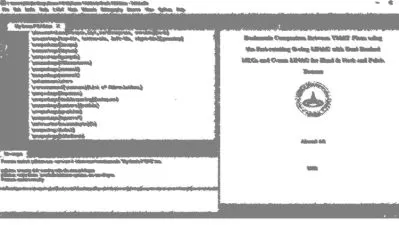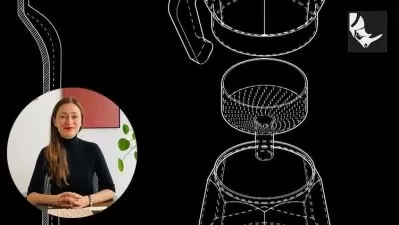Engineering Drawing Part III
Manas Patnaik
5:47:16
Description
"Mastering Engineering Drawing & Graphics: Sectioning and Development of Solids, Isometric and Perspective Projection"
What You'll Learn?
- After the end of this course, you guys will be able to interpret & comprehend technical drawings from the perspective of an Engineer.
- Section of Solids to visualize internal features.
- Learn Developing Surface of Standard Hollow Solids
- Learn Isometric Drawings via excellent examples.
- Explore Perspective Projection through animations and examples
Who is this for?
What You Need to Know?
More details
Description         This course is all about learning the elements of Technical / Engineering Drawing. A picture is worth a thousand words and an animation is worth a thousand pictures. And by the end of this course, you will realize how easy it gets to learn stuff from animations. This is not merely a subject to consume, but it's a language which allows engineers across various disciplines to communicate. This course is relevant across all disciplines of Engineering be it Mechanical, Civil, Electrical or Computer Science. This is a mandatory first year course in most of the universities globally.Â
In Part III of Engineering Drawing, we will be covering the following topics in depth:
1. Section of Solids: A section of a solid is a two-dimensional representation obtained by cutting or slicing the solid along a specific plane. It provides a clear and detailed view of the internal features, dimensions, and relationships within the solid, which may not be readily apparent from external views alone. Sections are particularly useful in illustrating complex shapes, hidden features, and assemblies, enabling engineers to analyze, evaluate, and communicate design intent effectively.
2. Development of Surfaces of Hollow Solids: Hollow solids, such as cylinders, cones, pyramids, and spheres, often possess curved surfaces that are challenging to represent accurately in two-dimensional drawings. By developing the surfaces of these objects, engineers can obtain a flat representation that can be easily measured, manufactured, and assembled. This technique plays a crucial role in industries such as sheet metal fabrication, carpentry, plastic molding, and pipe manufacturing.
3. Isometric Drawings: Isometric projection is a form of axonometric projection, which means that all three dimensions of an object are represented at the same scale and with equal angles. In isometric projection, the object is rotated at specific angles (usually 30 degrees) around two perpendicular axes, resulting in a 3D representation that shows all three dimensions—length, width, and height—equally and clearly.
4. Perspective Projection: Unlike isometric projection, which maintains equal scales and angles for all three dimensions, perspective projection mimics the way the human eye perceives objects in real life. It takes into account the concept of perspective, where objects appear smaller and closer together as they recede into the distance. By replicating this effect in engineering drawings, perspective projection provides a more accurate representation of the visual experience.
Â
Who this course is for:
- Students who are about to enter into their First Year of Bachelor of Engineering regardless of their branch.
- This course will also prove beneficial for school going students who have opted for Engineering Graphics or Engineering Drawing in their 11th and 12th Grade.
- Students of Diploma and Polytechnic can also enroll to this course as Engineering Drawing is a mandatory subject.
         This course is all about learning the elements of Technical / Engineering Drawing. A picture is worth a thousand words and an animation is worth a thousand pictures. And by the end of this course, you will realize how easy it gets to learn stuff from animations. This is not merely a subject to consume, but it's a language which allows engineers across various disciplines to communicate. This course is relevant across all disciplines of Engineering be it Mechanical, Civil, Electrical or Computer Science. This is a mandatory first year course in most of the universities globally.Â
In Part III of Engineering Drawing, we will be covering the following topics in depth:
1. Section of Solids: A section of a solid is a two-dimensional representation obtained by cutting or slicing the solid along a specific plane. It provides a clear and detailed view of the internal features, dimensions, and relationships within the solid, which may not be readily apparent from external views alone. Sections are particularly useful in illustrating complex shapes, hidden features, and assemblies, enabling engineers to analyze, evaluate, and communicate design intent effectively.
2. Development of Surfaces of Hollow Solids: Hollow solids, such as cylinders, cones, pyramids, and spheres, often possess curved surfaces that are challenging to represent accurately in two-dimensional drawings. By developing the surfaces of these objects, engineers can obtain a flat representation that can be easily measured, manufactured, and assembled. This technique plays a crucial role in industries such as sheet metal fabrication, carpentry, plastic molding, and pipe manufacturing.
3. Isometric Drawings: Isometric projection is a form of axonometric projection, which means that all three dimensions of an object are represented at the same scale and with equal angles. In isometric projection, the object is rotated at specific angles (usually 30 degrees) around two perpendicular axes, resulting in a 3D representation that shows all three dimensions—length, width, and height—equally and clearly.
4. Perspective Projection: Unlike isometric projection, which maintains equal scales and angles for all three dimensions, perspective projection mimics the way the human eye perceives objects in real life. It takes into account the concept of perspective, where objects appear smaller and closer together as they recede into the distance. By replicating this effect in engineering drawings, perspective projection provides a more accurate representation of the visual experience.
Â
Who this course is for:
- Students who are about to enter into their First Year of Bachelor of Engineering regardless of their branch.
- This course will also prove beneficial for school going students who have opted for Engineering Graphics or Engineering Drawing in their 11th and 12th Grade.
- Students of Diploma and Polytechnic can also enroll to this course as Engineering Drawing is a mandatory subject.
User Reviews
Rating
Manas Patnaik
Instructor's Courses
Udemy
View courses Udemy- language english
- Training sessions 30
- duration 5:47:16
- English subtitles has
- Release Date 2023/08/15










